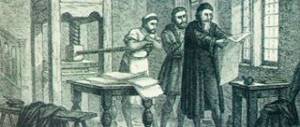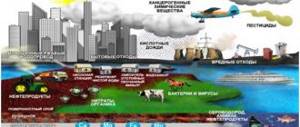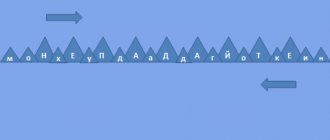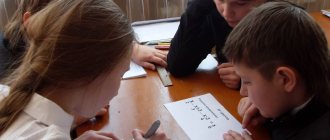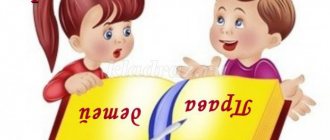Child protection
At the beginning of the twentieth century, adults began to think about creating a document that would protect the most defenseless citizens - children. Children are completely dependent on adults; they have no voting rights, no economic or political influence. It was clear that it was necessary to secure certain rights for them.
Rice. 1. Children around the world need protection.
Rights are the rules by which people live in a particular country. With their help, relationships between people in society are established.
In 1924, the world's first declaration of the rights of the child was created in Geneva. Declaration in translation means “announcement, statement.” It is advisory in nature and is a call to action in all countries.
The first declaration contained 5 basic principles protecting children from trafficking, slavery and violence. This was a real breakthrough in world jurisprudence, but the Geneva document needed improvement.
The Declaration was finalized by the UN, and an updated version was presented in 1959. It presents 10 principles by which adults should raise children.
TOP 4 articles that are read along with this
- 1. Constitution of Russia
- 2. Modern times: history continues today (4th grade)
- 3. Family tree (grade 2, surrounding world)
- 4. The world around us, topic: Nature of Russia
The Basic Law of Russia and human rights presentation for a lesson on the world around us (grade 4) on the topic
Slide 1
Basic Law of Russia and Human Rights Program: Educational and Cultural Complex “School of Russia”
Slide 2
Constitution The basic law of the state, defining its social and governmental structure, the procedure and principles for the formation of representative bodies of power, the electoral system, the basic rights and responsibilities of citizens.
Slide 3
Basic rights enshrined in the Constitution of the Russian Federation Personal (right to life) Civil-political (right to freedom of speech, conscience, thought) Socio-economic (right to work, rest, education, clean ecology) Cultural (right to one’s national culture)
Slide 4
Personal rights Right to life Right to protection from torture and violence Right to personal and family privacy
Slide 5
Political and civil rights The right to vote and be elected The right to choose a place of residence Freedom of speech, assembly, press Freedom of conscience
Slide 6
Economic and socio-cultural rights The right to work and free choice of profession The right to rest and leisure The right to health care and medical care The right to social security The right to education
Slide 7
Responsibilities of citizens: A citizen is obliged to comply with the laws of the state. A citizen must pay taxes and fees. A citizen must protect the Fatherland. A citizen must preserve nature. A citizen must take care of children and disabled parents. A citizen must protect cultural monuments.
Slide 8
Universal Declaration of Human Rights. The Universal Declaration of Human Rights is the fundamental international document proclaiming the inalienable and inviolable rights of all members of the human family. This document states that all people are born free and equal in their rights. Every person has all rights and freedoms regardless of nationality, language, gender.
Slide 9
Convention on the Rights of the Child. The right to be raised in a family environment. The right to adequate food and sufficient clean water. The right to an acceptable standard of living. The right to medical care A disabled child has the right to special care and education. The right to rest. The right to free education. The right to safe living conditions Children should not be used as cheap labor. The right to speak their native language, practice their religion, and observe the rituals of their culture. The inalienable right to life. The right to express one's opinion, to gather together for the purpose of expressing one's views.
Slide 10
Conclusion CITIZEN RIGHTS RESPONSIBILITIES CONSTITUTION For life For work For rest For education For medical care For freedom and personal integrity For protection of honor and dignity. Pay taxes Obey the laws Additional rights for children: To be loved and cared for UNIVERSAL DECLARATION OF HUMAN RIGHTS CONVENTION OF THE RIGHTS OF THE CHILD
Slide 11
Thank you for your attention!
Principles of the Declaration of the Rights of the Child
In short, the declaration states that all the best that humanity has belongs to children and cannot be taken away from them at someone’s whim.
Let's look at the 10 principles of the Declaration of the Rights of the Child:
- Absolutely all children on Earth, regardless of race, nationality, age, social status and place of birth, have the same rights. In no case can they be changed, diminished or completely canceled.
- From birth, every child anywhere in the world has the right to fully grow and develop, both physically and spiritually.
Rice. 2. Full development of the child is one of the principles of the Declaration.
- Children are citizens of their country, so parents must give their baby a name, and the state must give citizenship.
- For normal growth and development, all children, everywhere in the world, should receive quality medical care. They must also be provided with housing and social care.
- If there is a disability, the child must be surrounded by attention and appropriate care.
- Children have an absolute right to parental love and care, but if the child is an orphan, the state must take care of him.
- Children all over the world have the right to education, development and games, with the help of which they better understand the world around them.
Parents are obliged to monitor the development of their children. They must cultivate in them kindness, compassion, empathy for their neighbors. From an early age, a child must realize that under no circumstances should he offend other children or torture defenseless animals.
- Help and protection for the child must be provided first.
- All children must be reliably protected from any manifestations of cruelty and violence. Any corporal punishment, threats, rudeness, humiliation, or any trauma to the delicate child’s psyche are prohibited.
Rice. 3. Any type of violence is prohibited.
- Children have every right to live in love and mutual understanding. They cannot be raised in the spirit of hatred towards representatives of other social classes, races, and religions. With the help of parents, a child must understand from early childhood that all people on Earth are equal to each other.
Subsequently, based on these 10 principles, a Convention was created, the purpose of which is to regulate relations between children and adults and the rights of minors.
A convention is an agreement that must be complied with by the parties who signed it.
This Convention was fully supported by 193 countries around the world, including Russia. Based on this document, changes were made to the Civil and Family Code. All violators of children's rights are punishable by law. It is very important that children know about their rights and, if they are violated, are not afraid to seek help.
Educational game lesson in 4th grade on the topic “Children’s Rights”
Equipment: signs for the game “allowed”, “prohibited”, paper and pencils for drawing, pictures depicting bad and good actions of people. Progress of the lesson
1. Introductory part.
The teacher tells.
Once upon a time, thousands of years ago, people appeared on earth. At the same time, the main questions arose: What can people do and what can’t they do? What are they entitled to and what are they not entitled to? And people took on the solution of these main issues: in conversations among themselves, through various solutions, through international negotiations. In the end, people managed to resolve the main issues, and the Universal Declaration of Human Rights was born. Adults have many different rights. The main ones are set out in the Universal Declaration of Human Rights.
— Do children have any rights? (Children's answer: Yes, there are.) And they are written in the Declaration of the Rights of the Child, which was created and adopted by the United Nations (UN). It is important to know the rights of an adult and the rights of a child. But it is equally important to remember that, in addition to rights, a person also has responsibilities that are inextricably linked.
- It is necessary to cultivate in every child a sense of friendship and mutual understanding between peoples.
- No child can be sold or bought.
- Every child has the right to free and compulsory education.
- No young child may be separated from his mother except in exceptional cases.
- Every child needs love and attention.
- Every child from the day of birth has the rights to citizenship and his own name.
2. Quiz “Rights”
The names of fairy tales are written on the board. Children answer by naming a fairy tale. “Thumbelina” 1. In which fairy tale is the right to the integrity of life violated? “Harry Potter” 2. In which work is the right to privacy of correspondence violated? “The Three Little Pigs” 3. In which work is the right to privacy of the home violated? “Golden Key” 4. In which work is a person’s right to own his home violated? “Moroz Ivanovich” 5. In which work is the right to rest and leisure violated? “Cinderella” 6. In which work is the worker’s right to fair remuneration violated? "Little Red Riding Hood"
3. The game “Allowed - prohibited.”
Teacher. Guys, you already know that all people - adults and children - have various rights: to life, study, work, rest, etc.
I suggest you play the game “Allowed - Forbidden”.
I will talk about some right, and you will find the sign corresponding to it and answer: “Permitted or prohibited.” There’s a little boy standing in the corner, crying and struggling. Beating, punishing a child Strictly...(prohibited.) Children should live with their mother, Always give her flowers - This...(allowed.) This line means: Mother and child are separated. This...(prohibited.) Draw and sing, study, If you are sick, get treatment. This...(allowed.) This child is working, He has little strength, His legs are giving way. In childhood, hard work...(Prohibited) Living together in peace together, Being friends with different children is...(allowed.)
Class hour "Me and my rights" 4th grade
Lesson objectives:
generalize students' knowledge about the basic rights of the child, show the unity of children's rights and responsibilities, cultivate respect for the statements of classmates and their rights, focus children's attention on the need to understand and know their rights and responsibilities, develop students' creative potential, use various forms of testing students' knowledge - individual, group.
Equipment:
multimedia equipment, presentation, children's drawings
Progress of the lesson
- Teacher's opening speech
A long time ago, thousands of years ago, people appeared on Earth. At the same time, the Essential Questions emerged: What can people do and what can’t they do? What are they obligated to do and what are they not obligated to do? What are they entitled to and what are they not entitled to? Without a clear answer to these questions, life turned into a complete nightmare and confusion. And people took up the solution of these Main Issues in ordinary conversations among themselves, through international negotiations. During these negotiations, the adults of the world decided to develop a document to protect the children on planet Earth, they decided to develop such a document so that all children had the same rights.
-What is the name of this document?
— Convention on the Rights of the Child.
— Convention
is
an international agreement.
It states that the states that signed it have committed themselves to taking care of you, your health, well-being, education and comprehensive development.”
— Do you think all children on Earth live well? Why? (children's answers)
“Every year, 3.5 million live from theft, exhausting work, begging, because... abandoned by their families, 120 million children aged 6 to 11 are deprived of the opportunity to go to school.”
Working with a proverb
-Russian folk proverb says “Don’t build a church, build an orphan”
. How do you understand this proverb?
The problem of orphanhood is acute in Russia. A lot of children are in orphanages without parental care. We may not build a church, but if we try to shelter an orphan, give him education, love, care, then this will be the kindest thing.
- Quest “Magic Flower”
-Guys, now we will try to collect a magic flower that helps people live in peace and harmony.
-Look at this drawing, tell me what is shown on it.
In this fig. depicts a student at school.
- So what right is depicted?
1.Right to education.
Where do they get their education?
-At school, in universities, colleges, institutes.
2. The right to receive medical care.
Where do we get medical care? We receive medical care at the hospital.
What is shown and what is written in this picture?
What kind of right do you think this is?
3.Right to a name.
How can you prove that your name is exactly that and not another? Why didn't you appropriate someone else's first and last name?
This information is recorded in a special document - a birth certificate..
Here you also write your date of birth, where you were born, and who your parents are. This is the child's first document. Each of you has it.
What is shown in this picture. I see children at the computer and TV. What kind of right do you think?
4 . Right to information.
This is the right to receive information. What other sources do you get information from?
We receive information from the pages of newspapers, magazines, television, and computers. Every child has this wonderful right.
Who do you see in this picture?
- In Fig. children in national clothes. What right do you think is shown?
5.
The right to observe one’s traditions, culture, speak one’s native language, and preach one’s religion.
-What religion do Kalmyks preach, what traditions are there?
-We preach Buddhism as a religion, we have traditional Kalmyk holidays Tsagan Sar, Zul.
-And what religion is preached on the territory of Kalmykia?
-Christianity, Islam.
-Who preaches Christianity?
-Russians, who is Islam?
-What is shown here?
-The children are resting. What kind of right do you think this is?
6. The right to rest, games, leisure, and comprehensive development.
-How do you understand the right to comprehensive development?
-Children can attend art and music schools, and attend sports clubs.
— Rights do not need to be purchased, earned, or inherited. They belong equally to all people, regardless of nationality. Rights cannot be taken away—no one can take away the rights of another person, for any reason. We are all born free and equal.
— To become a full-fledged citizen of society, you need to know your rights.
- So, we collected a magic flower.
-Now tell me, what is the name of our flower?
-Our flower is called the Convention on the Rights of the Child.
Conclusion. The child has the right:
— The right to life, to a name at birth, to medical care, to education, etc.
Competition “Song about the rights of the child.”
“I suggest you now exercise your right to rest.”
-Now you will hear excerpts from your favorite children's songs, and you will have to say what rights they are talking about.
“Song of the Bremen Town Musicians” (music by G. Gladkov, lyrics by Yu. Entin) - “There is nothing better in the world...” (Right to freedom of movement. Right to freedom of peaceful assembly.): “What they teach at school” (music by V. Shainsky , words by M. Plyatskovsky). (Right to education.) “Song of a baby mammoth” (music by V. Shainsky, lyrics by D. Nepomnyashchaya). (The right that a child not be separated from his parents against their wishes) “Chunga-Changa” (music by V. Shainsky, lyrics Yu.Entina). (The right to enjoy benefits, the right to rest). Dramatization "Game"
Presenter: After lessons the guys decided to play. Erdnya: - Let's play war! Erdnya: - That's great! I will be the commander. And you, Andrey, will be a policeman. And you, Bova, will be a bandit. Bova: - But I don’t want to. Erdnya: - What don’t you want? Bova: - Play war. Erdnya: - How come you don’t want to? Everyone will be there, but he won’t. You will. Bova: - I don’t want to. Andrey: - If you want. Bova: - What are you going to force me to do? Host: - Let's figure it out, guys. Who is right? Who's wrong?
I think Bova is right.....
Why do you think that Bova is right?
Conclusion
The child himself must decide whether to play or not. You cannot force a child to do something he does not want. Unfortunately, very often many, knowing their rights, use them only for the benefit of their own interests, without regard for others. For example, you like to listen to loud music. But if you prevent someone from reading a book, or there is a sick person nearby, then you are violating the rest rights of another person. You can only exercise your rights if you do not violate the rights of others .
"Fairytale Quiz"
- Having examined the drawing, you must determine the name of the fairy tale and the author. Based on the articles of the Convention on the Rights of the Child, say what rights are violated here, and help the fairy-tale hero protect his rights.
"Kolobok"
- What is the name of the fairy tale? Who is author? (Russian folk tale “Kolobok”).
— The fox says: “Kolobok, Kolobok, I’ll eat you!”
— What should Kolobok answer when defending his rights? (You have no right to encroach on my life).
—
What is the name of this fairy tale? Who wrote it?
Rus. adv. fairy tale "Masha and the Bear"
«.
— What right did the bear violate by not letting Mashenka go home?
- The bear said: “Masha, you will live with me, light the stove, cook porridge.”
— How should Masha respond when defending her rights?
(You have no right to deprive me of freedom)
"The Adventure of Pinocchio"
—
Name a fairy tale. Who is author? Alexey Nikolaevich Tolstoy
- What article did Karabas-Barabas violate when he hung Pinocchio on a hook and then wanted to throw him into the fire?
- “You have no right to subject me to torture and cruel treatment.”
"The Fox and the Hare"
—
Who knows the title and author of this fairy tale? (Fox and Hare).
- What article did the Fox violate by kicking the Bunny out of the house? (article 16)
- How should the Bunny answer? (You have no right to invade my home, it is inviolable).
"Cinderella" Charles Perot
—
Name a fairy tale. Who knows the author? (“Cinderella” by Charles Perrault).
— The stepmother forced Cinderella to work from morning to night. She was forbidden to participate in the fun and entertainment of her sisters.
- What article did the stepmother violate? (Article 31 and 32).
-Cinderella: “You have no right to deprive me of rest and leisure.”
Discussion of the situation
:
Let's remember the familiar fairy tale of G.-H. Andersen's "The Ugly Duckling"
– Did all the inhabitants of the poultry yard have the same rights?
- Why did they offend the little duckling?
— Do people have the right to treat badly a person who is not like them?
-Everyone is born free and equal in rights.
Training.
— We talked a lot about rights. Continue this phrase: “For me, the most important right is...”
- Well done! Now let's talk a little about your responsibilities as schoolchildren.
- School students are required to:
- comply with the school charter;
- study conscientiously;
- treats school property with care;
- comply with the Rules of Student Conduct.
- Students are required to take care of the environment
Remember
: Rights are granted and responsibilities are fulfilled!
Lesson summary
-What did we talk about?
-We talked about the rights of the child.
— Which document states the rights of the child?
-In the Convention on the Rights of the Child. This document is intended to protect the rights of the child. On the way to this goal, we must change the world. Let's start with small steps, from our environment, in the family, at school, on the street.
- Why do you need to know them?
-To be able to protect yourself from the arbitrariness of adults, to exercise your rights. All children must be confident that the state will always take care of and protect their interests and will ensure that everyone, without exception, has the right to be a full-fledged citizen of their country.
— Knowing your rights is very useful, it gives you self-confidence.

